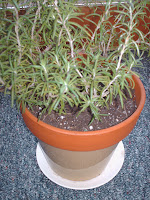Test Results: Beet and yellow bean seed germination rate 0%. Will need to buy some. Lucky for me, Oakland Nursery is having a seed sale beginning March 7.
It's the last week in February. Still way too early to start seedlings indoors. But the bitter cold and dreary day drove me to lift my spirits the only way I know how....dreaming of spring.
I spent a nice hour visiting with my vegetable, herb and flower seeds. Back in January, by a quick, unscientific inspection and count, I determined I had enough seed for the gardens. The only seeds I ordered from Burpee this year were peas, basil, zucchini and loose leaf lettuce. I had none of these standards.
Leisurely looking through my seeds today, I found lots going back to 2004. Some packs had not been opened and some were still in vacuum-packed pouches. I'm fairly hopeful my penny-pinching decision not to purchase more of what I already have will not backfire.
As of today though, I'm hedging my bet by scientifically testing the viability of the older seeds (lots '04 through '06). In a southern exposure, between two damp paper towels, I placed 10 each of yellow bean, carrot, lettuce, tomato, beet, cucumber, radish, cabbage and radish seeds. The tray is covered with cling wrap to keep in the moisture. I'll check the tray over the next 5-10 days and count how many seeds of each variety sprout. If less than 3, then, I'll be buying new; around 5, I'll have to double plant. Here's hoping the seeds germinate at a high rate!
22.2.09
16.2.09
American Bittersweet

American Bittersweet (Celastraceae) during the summer with ripening fruit.
------------------------The first fall after moving to our rural home, I made friends with a woman from church. She designed and created gorgeous dried arrangements and wreaths.
I had this enormous vine of a plant growing up a light pole in my backyard. I had no idea what it was. It did have pretty little clusters of red and orange berries with ariles. So, I snipped a branch and took it over to show her.
Her eyes lit up as she gasped, "Where did you get that?" Turns out, I had bittersweet. Bittersweet is highly prized for its use in dry flower arranging. It's also pricey.
Broadly twining, bittersweet is native dioecious and is not always welcome by farmers. As my friend put it, "There's a Round-up mentality about bittersweet in these parts." She was very happy to take as much of the berried branches that I could reach. The rest were left for the birds to eat.
14.2.09
Spike Speedwell

Spike speedwell (Veronica spicata) is an herbaceous perennial with spiked, tubular flowers. The flowers are a cool blue. The blue pops against the plant's dark green leaves. Speedwell also comes in pink.
Suited to sun as well as partial shade, my speedwell grows happily under a volunteer scrub willow. Low maintenance and low growing (it reaches 1.5 to 2 ft.), speedwell is a wonderful perennial to plant at the front edge of the flowerbed.
Pluses: Speedwell is deer resistant and attracts pollinators for the nearby vegetable garden. Rating: Excellent and easy care for Zone 5 growing.
8.2.09
"There's rosemary, that's for remembrance."

So wrote Shakespeare in Hamlet. For me, rosemary (Rosmarinus officinalis), also embodies remembrance.
Although this perennial herb is used to flavor meats, poultry and potatoes, I rarely use mine for this purpose. I'm slightly more romantic and cerebral about rosemary.
Several years ago, I placed a small plant* in a pot and there it remains. As a potted plant, I take rosemary outside when the weather warms, inside when it cools. Rosemary's woody and evergreen-like needles are suited to the arid and sunny conditions of the wood deck. Unlike other potted plants that require daily watering during the summer months, rosemary is forgiving of a little neglect.
----------------
During these long winter months, there is nothing like the pungent, earthy-pine fragrance emitted from even the slightest brush of rosemary's leaves. The scent reminds me of times in the garden. It's a reminder of why I garden.
*Grows in zones 7 -10. In zone 5, it must be either dug up or grown in pots and brought inside.
Subscribe to:
Comments (Atom)



